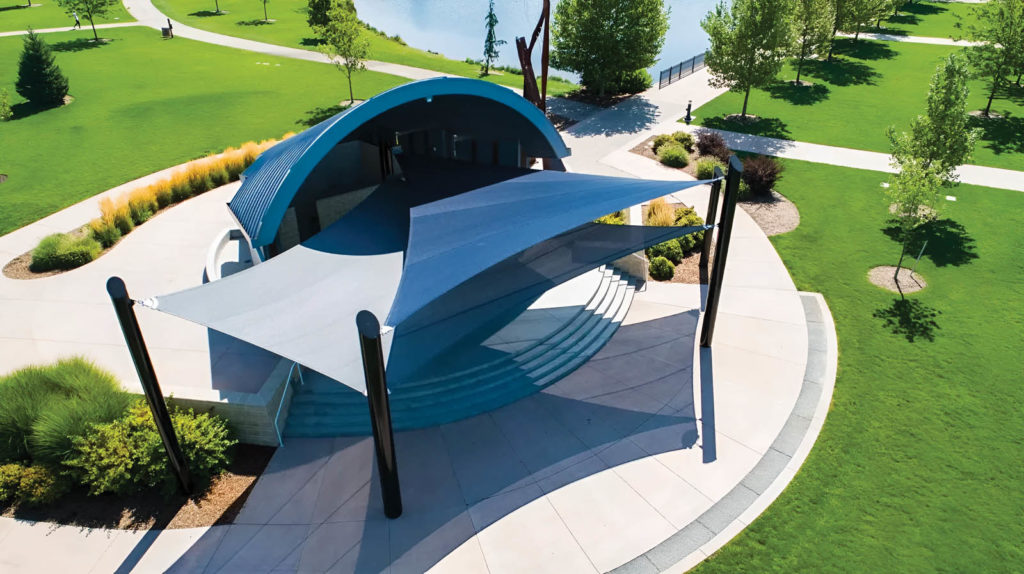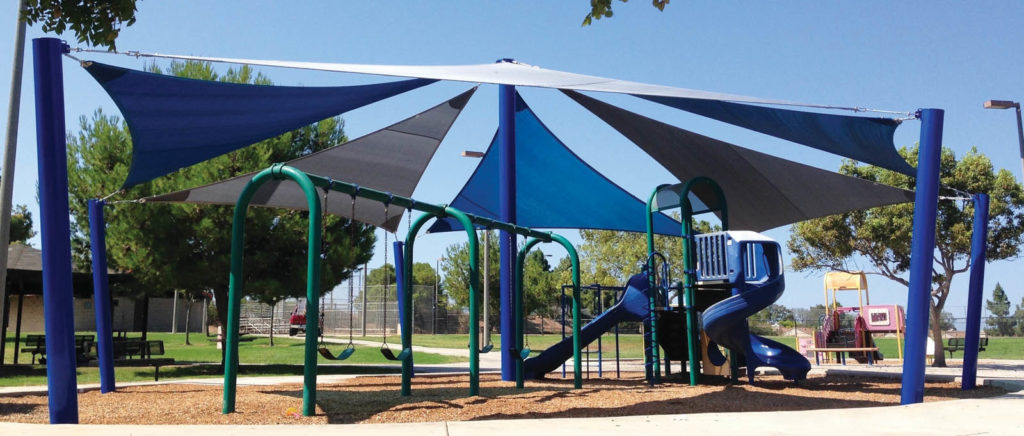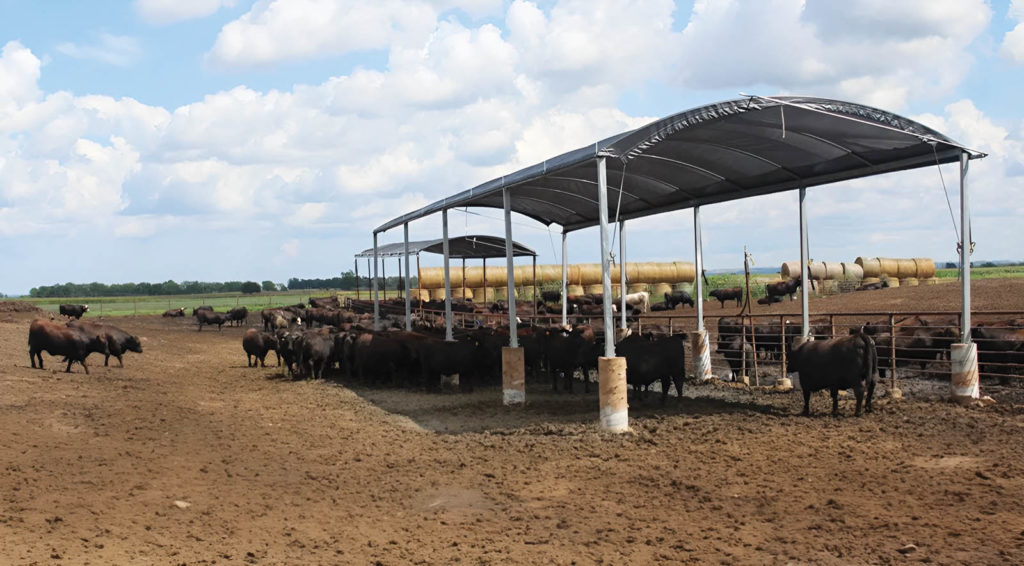
Cool, comfortable shade is easy to underestimate and hard to ignore when it’s not available. Bill Moore saw an opportunity in the fabric shade business when he moved from New England to California in the early 2000s. “I was struck by how much good space was going unused, due to the sun.”
Moore started researching fabric shades and decided they offered enough potential to grow a business. In 2005 he created Shade Comforts, a design-build contractor of cable-tensioned, shade-fabric structures for California organizations, based in the San Francisco bay area. He was inspired by new uses for shade cloth that appeared in the early 1990s in warm, sunny climates like Australia and South Africa.
“Those areas were experiencing higher rates of skin cancer, and modern fabric shades helped protect people from the sun’s rays,” Moore says.
Beating the heat is a huge advantage, he says. “You can drop the temperature up to 20 degrees under the fabric. Compare that with a steel roof, which traps heat inside.”
Demand for Shade Comforts’ products has grown in the past 17 years, thanks to commercial and business clients, schools, churches, municipalities and more. “About 90 percent of our work involves water-resistant, high-density polyethylene,” says Moore, who noted that Shade Comforts’ fabric shades come with a 10-year warranty. “Everything we do requires a building permit and site-specific engineering that we provide through our turnkey solutions.”
Many Shade Comforts products can withstand 110-mile-per-hour winds. This requires durable fabric and solid construction. The footings on Shade Comforts’ products are often 30 to 36 inches in diameter and are installed 7 to 10 feet deep, Moore notes.
Projects have ranged from an Olympic training center for target shooting to fabric-covered parking spaces to shade structures over an electric vehicle charging area at a car dealership. While the cost of installing a project depends on the style of the fabric shade and the site location, prices for Shade Comforts’ products typically start in the $30-per-square-foot range, Moore says.

Fabric shades protect agricultural productivity
Fabric shades aren’t just for parking lots and playgrounds. They are also the unsung heroes of livestock farming and food production. Shade is essential to curtailing the heat stress that can cause a decrease in feed intake, milk production, weight gain and fertility in beef cattle, according to Stephen F. Higgins, Ph.D., director of environmental compliance for the College of Agriculture, Food and Environment (CAFE) at the University of Kentucky.
When Higgins used an infrared temperature gun to measure the heat in a feedlot in his area on a summer day, the gravel measured 118 degrees Fahrenheit. The ground was 89 degrees in the shade, however.
Scientists at the University of Arkansas have found that providing cattle with artificial shade resulted in an average daily gain of more than 20 percent milk production, compared to cattle with no shade. In addition, research from the University of Florida indicates that dairy cows provided with shade produce 10 to 19 percent more milk than cows without shade.
Several companies provide fabric shade products for agricultural uses, including South Dakota-based Rush-Co. The company’s shade systems are engineered to withstand tough weather conditions, says Dan Fathke, sales and marketing manager. They are made with durable vinyl and mesh covers, along with galvanized steel that resists corrosion. Rush-Co Products’ livestock shades are found on cattle, sheep, goat and horse farms across the country. Along with the ag sector, the company services the marine market and provides custom commercial products.
In the agriculture industry, fabric buildings help protect livestock from the elements, providing shade and cooler conditions in the summer and a more comfortable environment in the winter. “Raising cattle under a roof is a growing trend, especially in areas where there’s not enough land for pasture, or the rent on existing pastures is more than a cattle producer wants to pay,” says Fathke, who is excited about technology advancements that are making fabrics more durable. “Once customers put up a fabric barn, they often put up another one in a few years.”

Shade structures provide critical protection
Being located in the middle of farm country is a plus not only for Rush-Co Products, but also for Celina Tent, in Celina, Ohio. The company, which serves markets ranging from the military to agriculture, has created a niche in the past five years with fabric curtains for modern ag barns.
“Each year our ag curtain business increases,” says Allan Bruns, an engineer with Celina Tent, which supplies curtains and shade products for hog and turkey barns and more. “Farming has become such a science today. Paying attention to details like barn curtains that provide proper cross-ventilation and shade can make a big difference in the comfort, health and productivity of the livestock.”
Beyond the farm, fabric structures offer nearly unlimited shade capabilities in urban areas, too, from concert venues to casinos. SkyWays® by Landscape Structures has provided fabric shades for recreational areas, including tennis courts, playgrounds and dog parks. It has also worked with zoos, amusement parks, amphitheaters, waterparks, splash pads, outdoor classrooms, public/community spaces like pavilions, corporate locations and more.
The company offers shade canopies, cantilever shades, single post shades, double post shades, hexagon/umbrella shades, and pyramid shade structures. Custom shades can be configured for projects requiring more specific design requirements.
The commercial shade structures from SkyWays provide critical protection, blocking up to 97 percent of the sun’s UV rays while making temperatures underneath the shade up to 30 degrees cooler, according to the company’s website.
Blocking UV rays is an important goal for any shade product, as they are the primary cause of skin cancer. There are two types of ultraviolet radiation, says Dennis Rushing, general manager of Industrial Shadeports in Fort Lauderdale, Fla. Longer wavelength Ultraviolet B rays cause tanning, but overexposure results in sunburn and in many cases blistering. It’s also the primary cause of skin aging.
Ultraviolet A rays have a shorter wavelength but penetrate the skin more deeply. “Exposure actually damages the DNA of skin cells on the innermost part of your top layer of skin, where most skin cancers occur,” says Rushing.
Tent, awning and shade structure sellers have an important role to play in reducing skin cancer by educating their customers to the damaging effects of the sun and explaining how they can help limit exposure. Properly installed and maintained shade structures can block up to 97.7 percent of UV rays.
Modern fabric shade structures can make any outdoor activity safer and more enjoyable. “I’m amazed at all the ways prospects and clients want to use fabric shades,” says Shade Comforts’ Moore. “That’s what makes this job so fun.”
Darcy Maulsby is a freelance writer based in Lake City, Iowa.
 TEXTILES.ORG
TEXTILES.ORG


